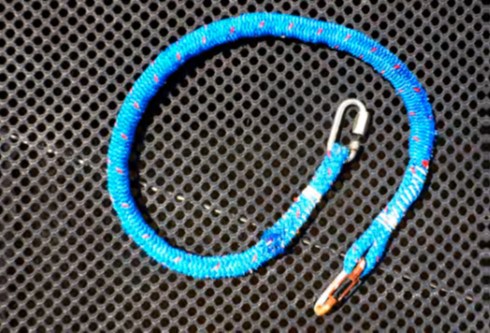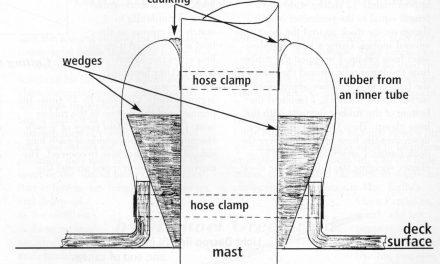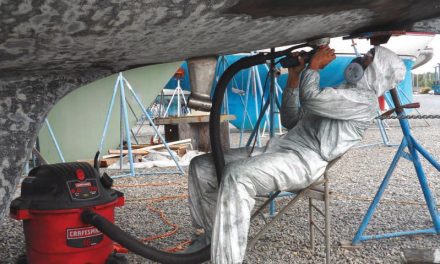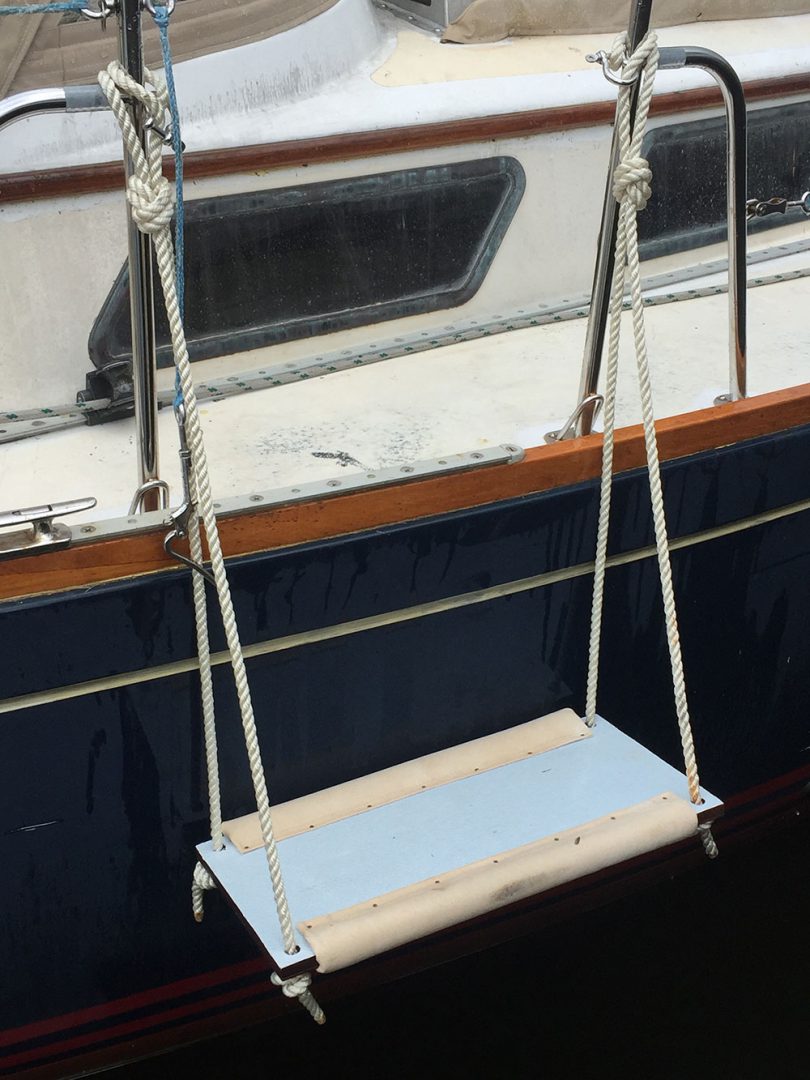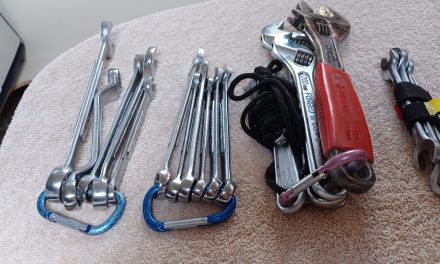If you’re tired of bogus bungees, try this custom-built alternative.
Issue 140: Sept/Oct 2021
The average bungee has a one- to two-year life expectancy when enduring stressors such as UV and chafe that are part and parcel of life aboard. The rubber cord is soon exposed, and failure follows. Discount cord can fail in six months, better cords may last a few seasons. And when they do snap, it is often without warning. In their final months, strength is greatly diminished. Using bungees alone to secure anything important can be risky.
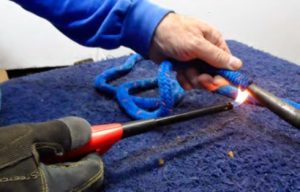
Using a mandrel to keep one end of the cover open, seal the edges of the double-braid so that it doesn’t fray.
For the past five years, I’ve been using much-improved webbing-covered bungees made by Davis Instruments and sold under the brand name Shockles. I use them to tension rigging and to secure a kayak on deck that is subject to green water on every windy sail. I’ve used them to control dockline slack, and they’ve withstood back-and-forth rocking through thousands of cycles.
They are sun-proof, chafe-proof, and fitted with versatile stainless carabiners or shackles rather than cheesy hooks. Even when the rubber core eventually breaks down and fails, the intact webbing cover remains and can hold thousands of pounds, depending on the size and level of normal weathering the webbing was subject to.
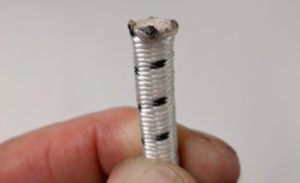
Always cut a shock cord with a hot knife;
seizing doesn’t work.
These “better bungees” are a little pricy, but I can get over that for gear that lasts. However, prefabricated construction comes with inherent limitations. The first is the fixed length. Second, elasticity is sometimes more than I need or want. Finally, the particular end fittings may not be the best for the respective application.
My DIY instincts sought a solution to these shortcomings. I made my own durable bungee cord to overcome them.
The only real skill a sailor needs to follow my lead is knowing how to sew an eye splice in rope. It’s a valuable skill apart from making a better bungee cord, so it would benefit everyone to learn. I wrote a Good Old Boat article on the subject for the May/June 2018 issue (“Sewn Eye Splices: Make Strong Connections with a Needle and Thread”). There’s also a how-to video on the Good Old Boat YouTube channel (go to youtube.com/ goodoldboat and search “sewn eye splice.”) Once you have this skill down, making your own better bungee should take about 15 minutes.
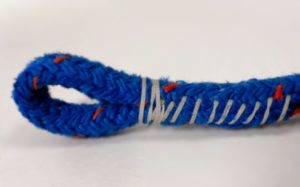
Sew the last 3 inches of the cover into an eye, using round turns on both sides and a row of stitches down the center to hold the end of the shock cord in place.
Here’s how to do it.
After determining the desired length of your finished custom bungee, assemble the parts you’ll need: a length of high-quality shock cord from a chandlery or name-brand cordage company that is at least as long as the bungee you’re making (I purchase a spool of this cord for projects like this), and a length of double-braid line with a salvageable cover; a retired dock line can work, but a halyard that was protected inside the mast is better. This length of line should be the maximum length you want your new bungee to stretch, plus 6 inches (in fact, limiting this maximum stretch range is a good way to ensure a longer lifespan for your bungee cord). The double-braid rope should be compatible in size with the shock cord; see the sizing compatibility chart (to use more than one shock cord inside a single cover, size up the rope accordingly so the cover diameter is large enough).
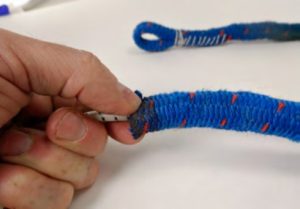
Push the cover toward the completed first eye until just the end of the shock cord sticks out; then you will allow 1-1/2 inches of the cover to slide back past this cord end to sew the second eye.
Stretch the shock cord between the two points to be connected, subtract 3 inches for the end eyes, mark, cut, and heat seal both ends (a hot knife is by far the best way to cut and seal shock cord).
Pull the cover off the double-braid line. Seal one end with a hot knife. Trim the other end, and then insert a mandrel. Melt the edges of this open end of the cover over the mandrel. This will allow you to insert the shock cord with minimal fraying and will simplify sewing the eye at that end.
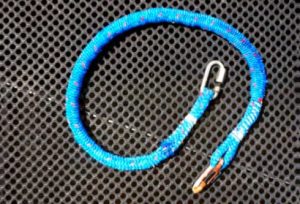
The completed better bungee.
Thread the cord into the cover.
At the sealed end of the cover, fold 3 inches over to make an eye. The shock cord does not go around the eye; the end of the cord should stop at the throat of the eye you are about to stitch. The eye only needs to be long enough for a shackle or lashing to fit through. Sew the sealed-end eye splice using #4 whipping twine, sewing down both sides of the cover at the throat of the eye, alongside the cord inside. Then sew two additional rows down the center through the cord, which will hold the end of the cord in place. This centerline stitching should extend for 1 to 1-1/2 inches.
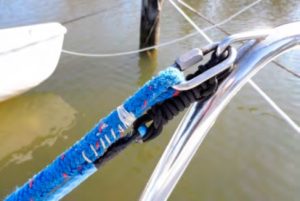
The better bungee in service.
Now, push the cover over the cord towards the end you just finished, bunching it up until only 3 inches of cover extend past the end of the shock cord inside. Fold the 3-inch length over to form the second eye, locking the cover in place with a needle through the shock cord. Sew the second eye in the same manner as the first.
Finally, add attachment hardware (such as carabiners) to the eyes. If you plan to use captive hardware, such as rings, add them before you sew the eyes.
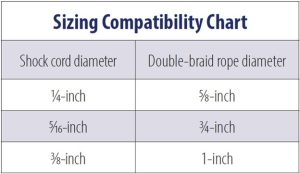 The resulting custom bungee will possess about 40 percent of the rated strength of the double-braid rope from which you harvested the cover, about 5,000 pounds if using new 5/8-inch rope. The range of stretch will be limited by the cover, appropriately protecting the bungee from over-extension. The cover will also protect the bungee from UV and chafe damage.
The resulting custom bungee will possess about 40 percent of the rated strength of the double-braid rope from which you harvested the cover, about 5,000 pounds if using new 5/8-inch rope. The range of stretch will be limited by the cover, appropriately protecting the bungee from over-extension. The cover will also protect the bungee from UV and chafe damage.
The new bungee will be comparatively bulky, but it will also be exactly the length you need with the precise attachment fittings that work best for the job at hand. The first examples of these I made were eight years old when I sold them with the boat, and they were still going strong.
Good Old Boat Technical Editor Drew Frye draws on his training as a chemical engineer and pastimes of climbing and sailing to solve boat problems. He cruises Chesapeake Bay and the mid-Atlantic coast in his Corsair F-24 trimaran, Fast and Furry-ous, using its shoal draft to venture into less-explored waters. He is most recently author of Rigging Modern Anchors (2018, Seaworthy Publications).
Thank you to Sailrite Enterprises, Inc., for providing free access to back issues of Good Old Boat through intellectual property rights. Sailrite.com

